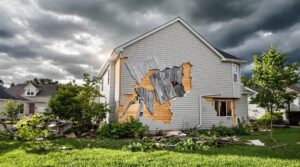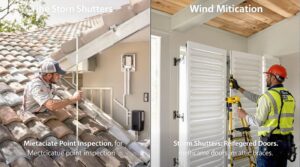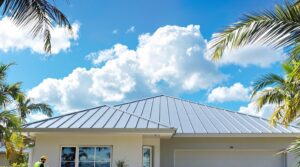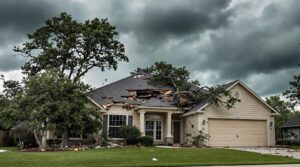Wind and hail insurance provides essential property protection with deductibles ranging from 1-5% of home value or fixed amounts of $1,000-$2,500. Geographic location profoundly impacts premium costs, with high-risk areas like Tornado Alley facing steeper rates. Homeowners can reduce costs through protective upgrades, policy bundling, and strategic deductible choices. Understanding policy exclusions, regional requirements, and maintenance strategies helps optimize coverage while managing financial implications of storm-related claims.
Key Takeaways
- Wind and hail deductibles can be fixed amounts or percentages, typically ranging from 1-5% of your home's insured value.
- Geographic location heavily influences insurance rates, with high-risk areas like Tornado Alley facing steeper premiums and stricter requirements.
- Common exclusions include cosmetic damage, gradual wear and tear, and flood-related issues, which require separate coverage.
- Installing protective features like storm shutters and impact-resistant roofing can qualify homeowners for significant insurance discounts.
- Regular maintenance and documented property improvements can help negotiate better insurance terms and reduce potential claim costs.
The Basics of Wind & Hail Deductibles
When homeowners face wind and hail damage to their properties, understanding deductible structures becomes essential for managing potential financial implications.
Wind and hail coverage within a homeowners insurance policy typically includes specific deductible provisions that determine out-of-pocket expenses before coverage activates.
These deductibles manifest in two primary forms: fixed dollar amounts and percentage-based calculations. While some policies specify a straightforward amount like $1,000, others establish deductibles as a percentage of the insured property's value, commonly ranging from 1% to 5%.
For example, storm damage to a $300,000 home with a 2% deductible would require $6,000 in out-of-pocket expenses before insurance coverage begins.
This structure emerged largely in response to catastrophic events, particularly in regions prone to severe weather.
Areas such as Tornado Alley and coastal zones frequently implement these specialized deductibles as standard components of insurance policies, reflecting the elevated risk of wind and hail incidents.
Regular policy reviews help homeowners identify potential gaps in their wind and hail coverage and ensure adequate protection against severe weather events.
Calculating Your Coverage Costs

Understanding the cost implications of percentage versus flat-rate deductibles is critical, as a 2% deductible on a $300,000 home results in a $6,000 out-of-pocket expense compared to potentially lower fixed amounts.
Analysis of premium differentials between these deductible types reveals that homeowners often pay higher premiums for the predictability of fixed-rate deductibles, necessitating careful evaluation of budget constraints against risk tolerance.
The ideal balance between premiums and deductibles requires consideration of regional storm risks, mandatory minimum requirements, and the homeowner's financial capacity to handle sudden expenses.
Regular policy limit reviews help ensure coverage keeps pace with changing home values and repair costs.
Percentage Vs Flat Rates
Steering between percentage and flat-rate deductibles presents homeowners with a critical financial decision that directly impacts their out-of-pocket costs during wind and hail damage claims. For example, a $300,000 home with a 2% deductible requires $6,000 out-of-pocket before coverage begins, while a flat dollar amount remains constant regardless of property value.
Key considerations when choosing between deductible types include:
- Flat-rate deductibles offer predictable costs and simplified budgeting
- Percentage deductibles fluctuate with property value and may result in higher expenses
- High-risk areas often face premium differences between the two options
In regions prone to severe weather, percentage deductibles can lead to substantially higher out-of-pocket expenses compared to fixed amounts.
This risk-based differential reflects insurers' assessment of potential claim frequency and severity in these locations.
Consider consulting with a public adjuster to better understand how deductible choices align with your property's replacement costs and coverage needs.
Out-of-Pocket Expense Analysis
The calculation of out-of-pocket expenses for wind and hail coverage requires careful analysis of deductible structures and potential repair costs. When evaluating percentage deductibles, which typically range from 1% to 5% of the insured value, property owners must assess their financial capacity to meet these obligations during a claim.
For instance, a property insured at $300,000 with a 2% deductible translates to $6,000 in out-of-pocket expenses before insurance coverage activates.
Alternatively, fixed-dollar deductibles offer more predictable costs, commonly set at $1,000 or $2,500. With wind and hail damage claims averaging $26,000 for small businesses, understanding these financial implications becomes essential.
Regular policy reviews guarantee property owners maintain adequate savings to cover their chosen deductible structure, preventing potential financial strain when filing claims.
Public insurance adjusters can help property owners navigate complex claims and identify underpaid settlements to ensure fair compensation.
Premium-Deductible Cost Balance
While managing out-of-pocket expenses focuses on immediate claim scenarios, calculating the ideal premium-deductible balance requires an extensive long-term financial analysis. Homeowners insurance policies for wind damage and property damage protection demonstrate a clear inverse relationship between deductibles and premiums. A lower deductible of $1,000 typically increases premiums by 25% compared to higher deductible options.
Key considerations when evaluating premium-deductible ratios:
- Higher deductibles (2-5% of home value) reduce monthly costs but require substantial reserves for potential claims.
- Local risk factors influence premium rates, averaging $1.43 per $100 of coverage in high-risk areas.
- Monthly premium savings must be weighed against financial capacity to cover larger deductibles during property damage claims.
This strategic balance guarantees adequate protection while maintaining sustainable insurance costs over time. Understanding claim coverage options helps homeowners customize their policies to match their specific needs and risk tolerance.
Geographic Risk Factors and Rate Variations
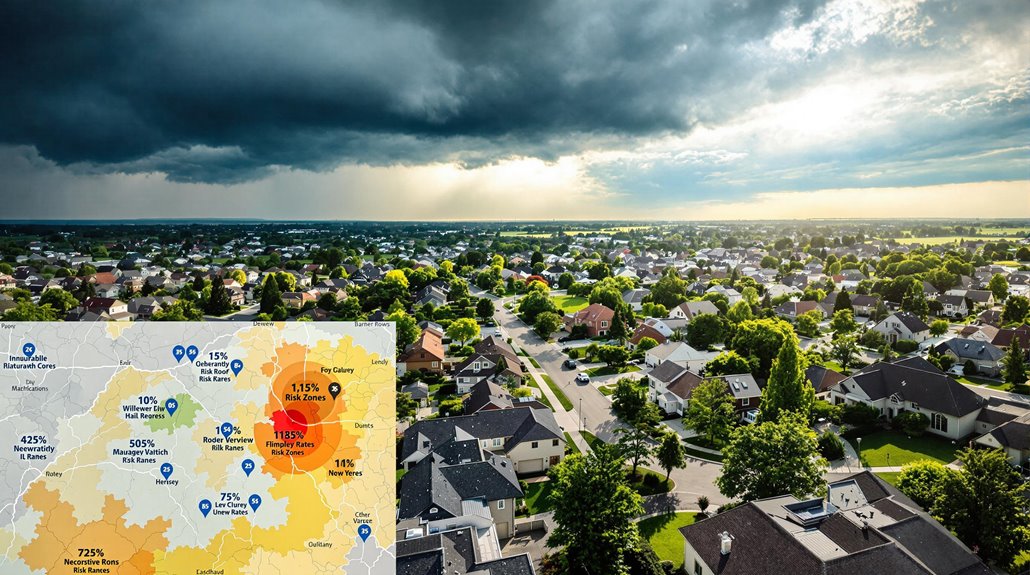
Geographic location plays a decisive role in determining wind and hail insurance rates, with significant variations across regions based on their exposure to severe weather events. Areas within Tornado Alley, including Texas, Oklahoma, Kansas, and Nebraska, typically face elevated insurance premiums due to their heightened risk of property damage from severe storms.
Coastal regions, particularly those susceptible to hurricanes, often require mandatory windstorm insurance coverage, which affects both availability and cost of policies. In these high-risk areas, organizations like the Texas Windstorm Insurance Association provide essential coverage options when private market alternatives are limited.
Insurance deductibles reflect these geographic risk factors, with minimum thresholds commonly set at 1% or more of the home's value in storm-prone regions. The limited number of insurers willing to provide coverage in high-risk geographic regions further contributes to premium variations, as carriers must balance their financial exposure against the probability of catastrophic weather events.
Percentage vs. Flat-Rate Deductible Options

When calculating percentage deductibles for wind and hail coverage, homeowners must account for substantial out-of-pocket expenses, as evidenced by a $6,000 deductible on a $200,000 home with a 3% rate.
Flat-rate deductibles offer predictable, fixed costs regardless of property value, typically ranging from $1,000 to $2,000, though they generally result in higher premium payments.
The choice between percentage and flat-rate options requires careful financial analysis, weighing the immediate ability to cover potential deductible payments against long-term premium costs.
Calculating Percentage Deductibles
Insurance providers offer two distinct deductible structures for wind and hail coverage: percentage-based and flat-rate options.
Calculating percentage deductibles requires understanding that the deductible amount directly correlates to your home's insured value. For instance, if insurance companies set a 2% deductible on a $400,000 home, homeowners must pay out of pocket $8,000 before coverage begins for damage to your home.
Key considerations when evaluating percentage deductibles include:
- Higher insured property values result in proportionally larger deductible obligations
- Percentage deductibles typically range from 1% to 5% of the total insured value
- Annual premium costs often decrease as percentage deductible rates increase
This calculation method greatly impacts financial planning, particularly in regions prone to severe weather events, where the potential for substantial out-of-pocket expenses increases with percentage-based structures.
When choosing between deductible options, carefully review your liability coverage needs to ensure comprehensive protection for your property and assets.
Fixed Rate Cost Comparison
Understanding the cost implications between percentage and flat-rate deductibles requires careful analysis of both short-term and long-term financial impacts.
While flat-rate deductibles work with predictable amounts like $1,000 or $2,000, percentage deductibles fluctuate based on the home's insured value, typically ranging from 1% to 5%.
Higher deductibles in percentage form can markedly impact homeowners in high-risk areas, where a 2% deductible on a $300,000 home results in $6,000 out-of-pocket costs for insurance claims.
Though flat-rate deductibles offer consistent expenses regardless of property value, they generally lead to increased premium costs.
Conversely, percentage deductibles may reduce annual premiums but potentially create larger financial obligations during claims, particularly for higher-value properties or those in wind and hail-prone regions.
Many homeowners opt to supplement their wind and hail coverage with personal liability insurance to protect against accidents or injuries that occur on their property.
Key Policy Exclusions and Limitations

Homeowners seeking wind and hail coverage must carefully evaluate their policy's exclusions and limitations to avoid potential gaps in protection. Insurance providers often restrict coverage through specific exclusions, particularly for cosmetic damage that doesn't impair functionality. Understanding these limitations is essential for adequate protection against windstorms and hail.
Key restrictions commonly found in policies include:
- Exclusion of cosmetic damage when surfaces remain functional
- Limitations or complete exclusions for high-risk structures
- Caps on reimbursement amounts for specific damage types
Insurance carriers typically deny claims related to wear and tear or gradual deterioration, considering these maintenance issues rather than storm damage.
Additionally, flood-related damage from storms requires separate coverage, as it falls outside standard wind and hail policies. Property owners should note that hurricane deductibles may differ from standard deductibles, potentially resulting in higher out-of-pocket expenses during claims.
Selecting the Right Coverage Level
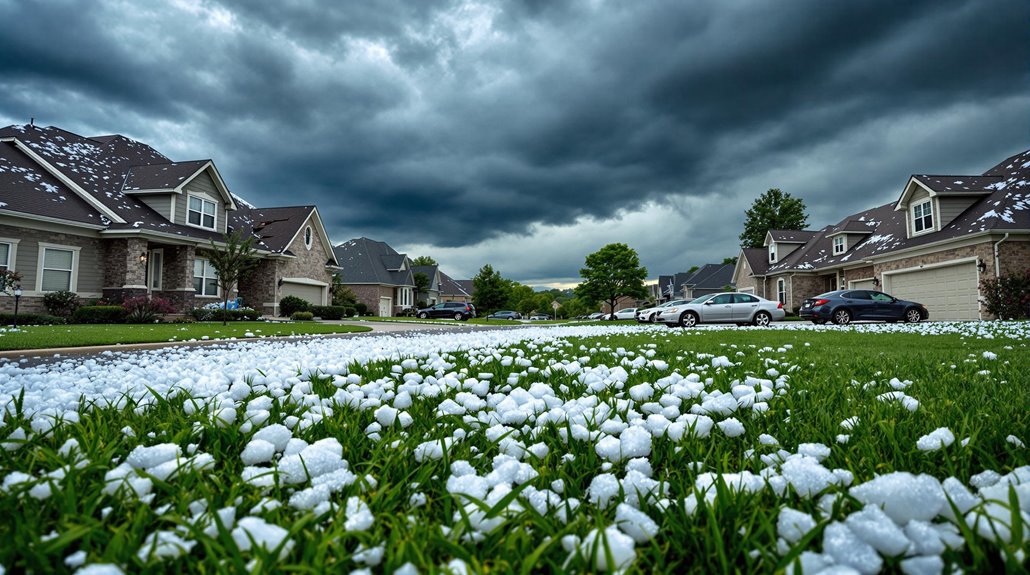
When determining appropriate wind and hail coverage levels, property owners must carefully assess both their geographical risk factors and financial capacity for deductibles. The selection process requires thorough evaluation of policy terms and conditions, particularly in regions prone to severe weather events. Replacement cost coverage should align with current construction costs and market values to ensure adequate protection. Property owners should analyze coverage options, comparing fixed-dollar deductibles against percentage-based alternatives. While fixed deductibles offer predictable costs, percentage deductibles typically range from 1% to 5% of the insured value, potentially resulting in higher out-of-pocket expenses. Regular market comparisons among insurers can reveal significant variations in premium costs and coverage structures, enabling more informed decisions. Careful attention to policy exclusions guarantees thorough protection against wind and hail damage, particularly in high-risk areas where adequate coverage is essential.
| Coverage Considerations | Risk Factors | Financial Impact |
|---|---|---|
| Deductible Amount | Location Risk | Annual Premium |
| Fixed Dollar Options | Storm History | Out-of-Pocket Cost |
| Percentage Based | Building Type | Claims Impact |
| Exclusion Terms | Local Climate | Long-term Value |
State-Specific Insurance Requirements

State requirements for wind and hail insurance vary significantly across regions, reflecting diverse geographical risks and historical weather patterns. Coastal states mandate specific hurricane coverage levels, while inland regions focus on general wind and hail protection. In Missouri, homeowners must pay a minimum deductible of 1% of home value or $2,500, whichever is greater.
Key regional variations include:
- Gulf Coast and East Coast states require mandatory windstorm and hurricane coverage
- Texas and Florida mandate additional coverage options in High Risk Areas
- Coastal regions implement separate, higher hurricane deductibles
Mortgage lenders often impose supplementary requirements beyond state mandates, particularly in storm-prone areas.
These requirements guarantee adequate protection for both the property owner and the lender's investment. Understanding local regulations is essential for homeowners, as non-compliance can result in coverage gaps or financial exposure during severe weather events. Working with independent insurance agents can help navigate complex state requirements while finding the most competitive rates and comprehensive coverage options.
Claims Process and Documentation

While regional insurance requirements establish the foundation for coverage, proper documentation serves as the cornerstone of successful claims processing. Homeowners must capture extensive photographic evidence and detailed descriptions of wind and hail damage to substantiate their claims effectively.
The claims process begins with prompt notification to the insurance company, ideally within the mandated timeframe of 30 to 90 days post-incident. Policyholders should maintain thorough records of temporary repairs made to prevent additional damage, as these costs may be eligible for reimbursement beyond the deductible.
An insurance adjuster will typically conduct an on-site evaluation to assess the extent of damage and verify documentation.
To guarantee the best claim resolution, homeowners must actively monitor their claim status and confirm receipt of all required documentation. This systematic approach helps facilitate smooth processing and increases the likelihood that damages will be appropriately covered under the policy terms.
For complex wind and hail damage situations, working with public insurance adjusters can help maximize settlement amounts through expert negotiation.
Premium Reduction Strategies

Although wind and hail insurance premiums can represent a significant expense for homeowners, several strategic approaches exist to effectively reduce costs without compromising essential coverage.
Understanding the insurance market and implementing premium reduction strategies can lead to substantial savings while maintaining extensive protection.
Key cost-reduction methods include:
- Selecting higher home insurance deductibles, which typically results in lower annual premium payments
- Bundling multiple insurance policies with a single provider to access multi-policy discounts
- Installing protective features like storm shutters and impact-resistant roofing to qualify for safety-related discounts
Regular evaluation of coverage options across different providers remains essential for optimizing costs.
Homeowners can further reduce premiums by participating in community risk-reduction programs and maintaining documentation of property improvements.
These strategies, when implemented systematically, enable property owners to secure necessary protection while minimizing financial impact through reduced premium costs.
Property Protection and Mitigation Measures
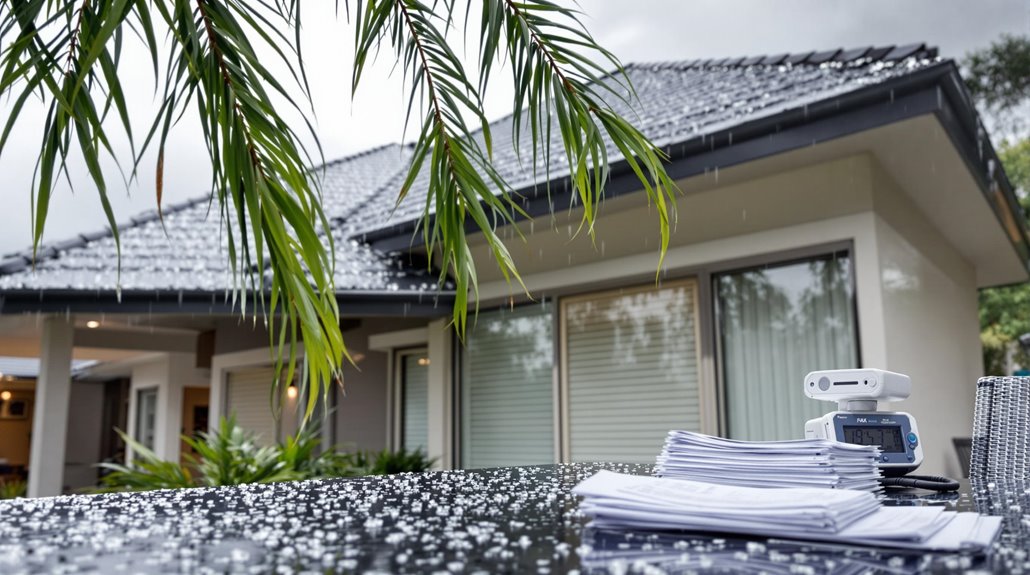
Strategic property protection against wind and hail damage requires a thorough approach to both preventive maintenance and structural upgrades.
Regular gutter cleaning, downspout maintenance, and strategic landscaping serve as critical first-line defenses against storm-related water damage and wind impacts.
Installing impact-resistant roofing materials, reinforced windows, and storm shutters represents a significant investment in long-term property resilience while potentially qualifying homeowners for reduced insurance premiums.
Preventive Building Maintenance Tips
Regular preventive maintenance plays an essential role in safeguarding properties against wind and hail damage. Insurance agents emphasize that proactive maintenance can greatly reduce potential claims and wind/hail deductibles.
A thorough maintenance strategy focuses on critical structural elements and surrounding features that protect the property from severe weather impacts.
Key maintenance priorities include:
- Regular roof inspections, ensuring shingles remain secure and debris-free
- Clearing gutters and downspouts to prevent water accumulation and drainage issues
- Reinforcing windows and doors with storm-rated protection systems
Additionally, maintaining proper landscaping serves as a defensive barrier against wind damage.
Strategic placement of trees and windbreaks can reduce wind impact on structures, while regular inspection of siding and exterior walls helps identify vulnerable areas requiring immediate attention to prevent water infiltration during storms.
Storm-Ready Property Upgrades
When homeowners invest in storm-ready property upgrades, they can substantially reduce their vulnerability to severe weather events while potentially qualifying for significant insurance premium discounts.
Key structural improvements include impact-resistant roofing, which can lower deductible amounts by up to 30% for wind- or hail-related claims. Storm shutters and protective window films provide critical defense against flying debris, while reinforced garage doors prevent catastrophic structural failures during high winds.
Deductibles are typically adjusted favorably when these protective measures are implemented. Additionally, proper drainage systems and strategic landscaping decisions, such as maintaining appropriate tree distances from structures, serve as essential components of thorough storm protection.
These storm-ready property upgrades not only safeguard homes but also often result in reduced insurance premiums through decreased risk exposure.
Frequently Asked Questions
What Should My Deductible Be for Wind and Hail?
Deductible options typically range from 1-5% of coverage limits, requiring careful policy comparisons. Homeowners should assess financial readiness for insurance claims while balancing storm preparedness needs against premium costs.
How Much Does Wind and Hail Insurance Cost?
Wind and hail insurance costs vary markedly based on regional differences and risk assessment, with annual premiums ranging $500-$2,000. Coverage limits and claims process requirements influence final pricing in high-risk areas.
Why Is My Wind Hail Deductible so High?
In Oklahoma, where tornadoes caused $2B in damages last year, insurers set high wind-hail deductibles to manage weather-related damages, balance coverage limits, and maintain sustainable claim processes through insurance policy adjustments.
Is Wind and Hail Insurance Necessary?
Wind and hail insurance proves necessary in storm-prone regions, as it provides critical home protection against severe wind damage and hail damage, preventing substantial out-of-pocket expenses from insurance claims within coverage limits. Additionally, many homeowners may not fully understand the specifics of their policies, which is where ‘wind and hail insurance explained‘ can provide invaluable insight. By clarifying the terms and conditions associated with this type of coverage, homeowners can make informed decisions about their protection strategies. In regions frequently affected by severe storms, having this insurance not only safeguards property but also offers peace of mind during unpredictable weather events.
Final Thoughts
Wind and hail insurance demands careful analysis of deductibles, coverage limits, and regional risk factors. Property owners must weigh percentage-based versus flat-rate options, understand policy exclusions, and maintain thorough documentation. Through strategic mitigation measures, proper coverage selection, and compliance with state regulations, stakeholders can minimize financial exposure while maximizing protection against these weather-related perils.
When dealing with property damage claims related to wind and hail damage, insurance industry professionals and legal experts strongly advise homeowners to contact a qualified state-licensed public adjuster. These professionals work exclusively for policyholders, not insurance companies, serving as dedicated advocates throughout the claims process. Public adjusters are state-licensed professionals who help navigate complex insurance policies, identify hidden damages often unknown to policyholders, thoroughly document losses, and negotiate with insurance companies to ensure fair settlements while protecting policyholder rights.
A public adjuster's expertise can prove invaluable by maximizing claim payouts, expediting the claims process, and reducing the stress associated with handling insurance claims. This allows homeowners to focus on recovery while ensuring their interests are properly represented. Policyholders interested in discussing their property damage or loss claims can request a no-obligation free consultation with a Public Claims Adjusters Network (PCAN) member public adjuster through our contact page.

